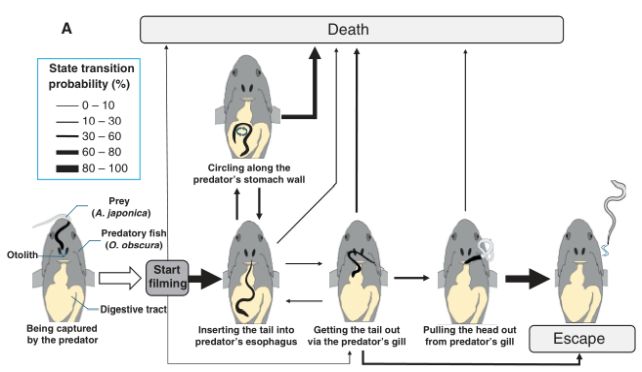Amazing Footage Shows How Eels Escape Death After Being Swallowed
The wacky Houdini hijinks of a slippery eel have finally been revealed – and caught on film for all the world to see.
Using X-ray video, scientists have discovered that baby Japanese eels (Anguilla japonica) slither backwards out of the stomachs of predatory dark sleeper fish (Odontobutis obscura) after being swallowed, and slip away through the gill slits to freedom.
“This study is the first to observe the behavioral patterns and escape processes of prey within the digestive tract of predators,” marine biologists Yuha Hasegawa and Yuuki Kawabata of Nagasaki University told ScienceAlert.
“At this point, the Japanese eel is the only species of fish confirmed to be able to escape from the digestive tract of the predatory fish after being captured.”
Hasegawa, Kawabata, and ecologist Kazuki Yokouchi from the Japan Fisheries Research and Education Agency first discovered that the eel had an interesting escape strategy a few years ago, when they observed juvenile eels, known as elvers, slithering out of the gills of dark sleepers after the elvers had been caught.

Active escape from the digestive tract of a predator has only been observed a few times, but mainly in invertebrates, such as a beetle that makes its way out a frog’s butt unharmed after being swallowed, or a parasitic worm that escapes from its insect host and the predator that ate its host, through pretty much any opening it can find.
The researchers wanted to know more about how Japanese eels evade digestion, since it was unclear whether their escape strategy was purposeful. So they set up an experiment to find out – using X-rays to see what happens inside the fish after the eel disappears into its jaws.
Elvers that were raised in a lab were injected with barium sulfate, a contrast agent to make them appear clearly in X-ray images. Then, one by one, the elvers were placed in a tank with a dark sleeper, and the resulting predator-prey interactions were recorded using X-ray video.
Of the 32 eels that were caught by the fish, 13 managed to find their way to the gills and start to escape. Nine eels completed their escape and wiggled free.
But it was how the eels escaped, revealed in the X-ray video, that stunned the researchers. The prey was completely swallowed by the fish prior to escape, which was effected by wriggling and squirming backwards, tail-first, back up the fish’s esophagus.
“At the beginning of the experiment, we speculated that eels would escape directly from the predator’s mouth to the gill,” the researchers said. “However, contrary to our expectations, witnessing the eels’ desperate escape from the predator’s stomach to the gills was truly astonishing for us.”
And it does seem to be very active indeed. Eels that didn’t escape were still observed circling the stomach of the fish as though looking for the escape route as quickly as possible: The average time each eel was active inside the fish was 211 seconds before succumbing to the hostile digestive environment.
“This discovery has provided us with new insights: muscle strength and tolerance to highly acidic and anaerobic environments, as well as their elongated and slippery morphology, are necessary for eels to quickly escape from the digestive tract before being digested,” Hasegawa and Kawabata said.
It’s not a 100 percent success rate for the Japanese eel, but it’s certainly a darn sight better than not trying to sashay out of danger.
Although a daring escape from the literal jaws (and stomach) of death seems to be a rare strategy for survival among animals, it’s possible that there are more out creatures there with the same capability.
The researchers say that studying it in those few animals we know about could help us figure out the traits that facilitate the ability.
“The X-ray method utilized in this study is applicable for observing the post-capture active escape of other prey inside a predator and identifying the specific organs that pose challenges for their passage,” they write in their paper.
“Such knowledge will provide valuable insights into the kinematic, physiological, and behavioral traits that are crucial for successful escapes, thereby offering new insights into the evolution of post-capture anti-predator tactics in prey.”
The research has been published in Current Biology.
